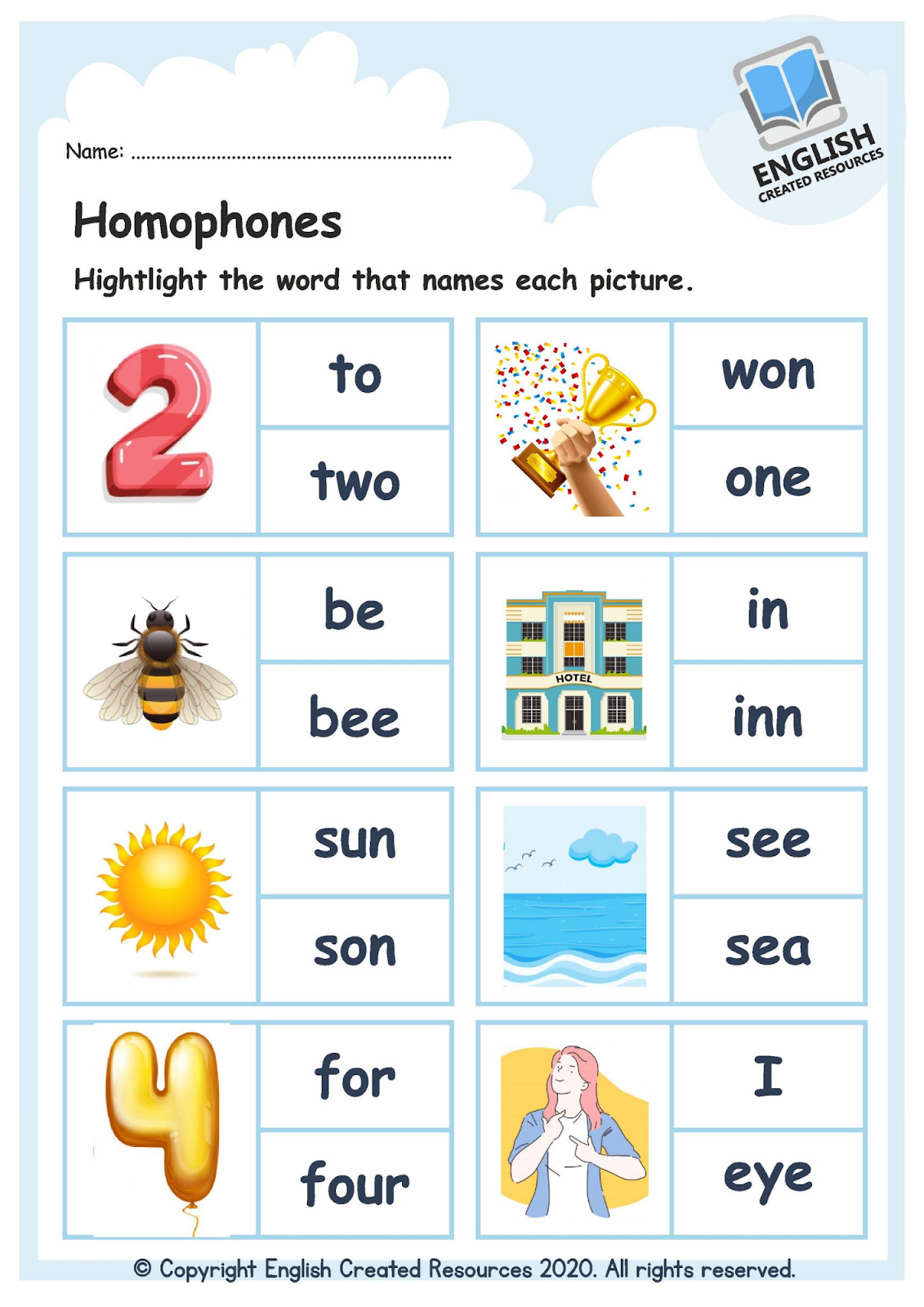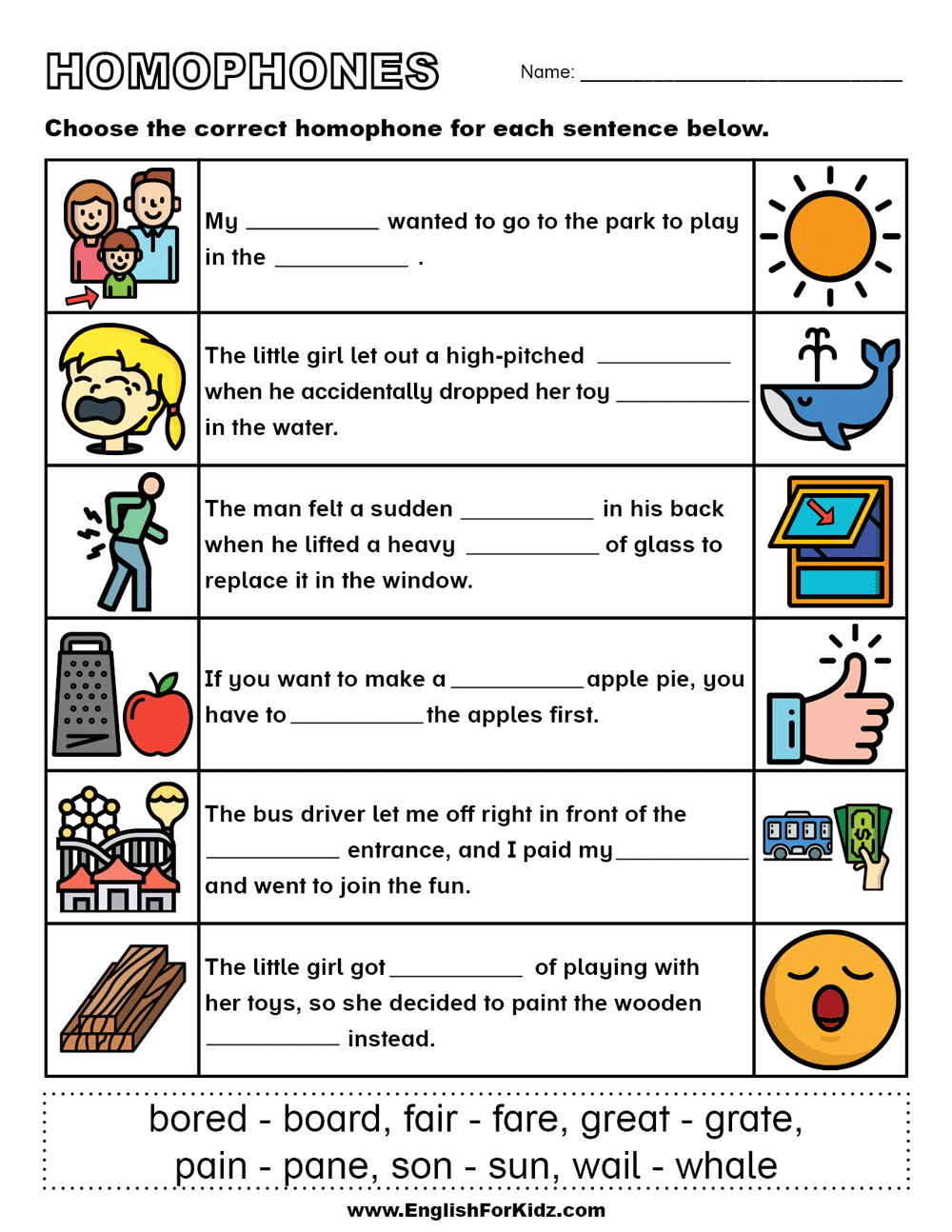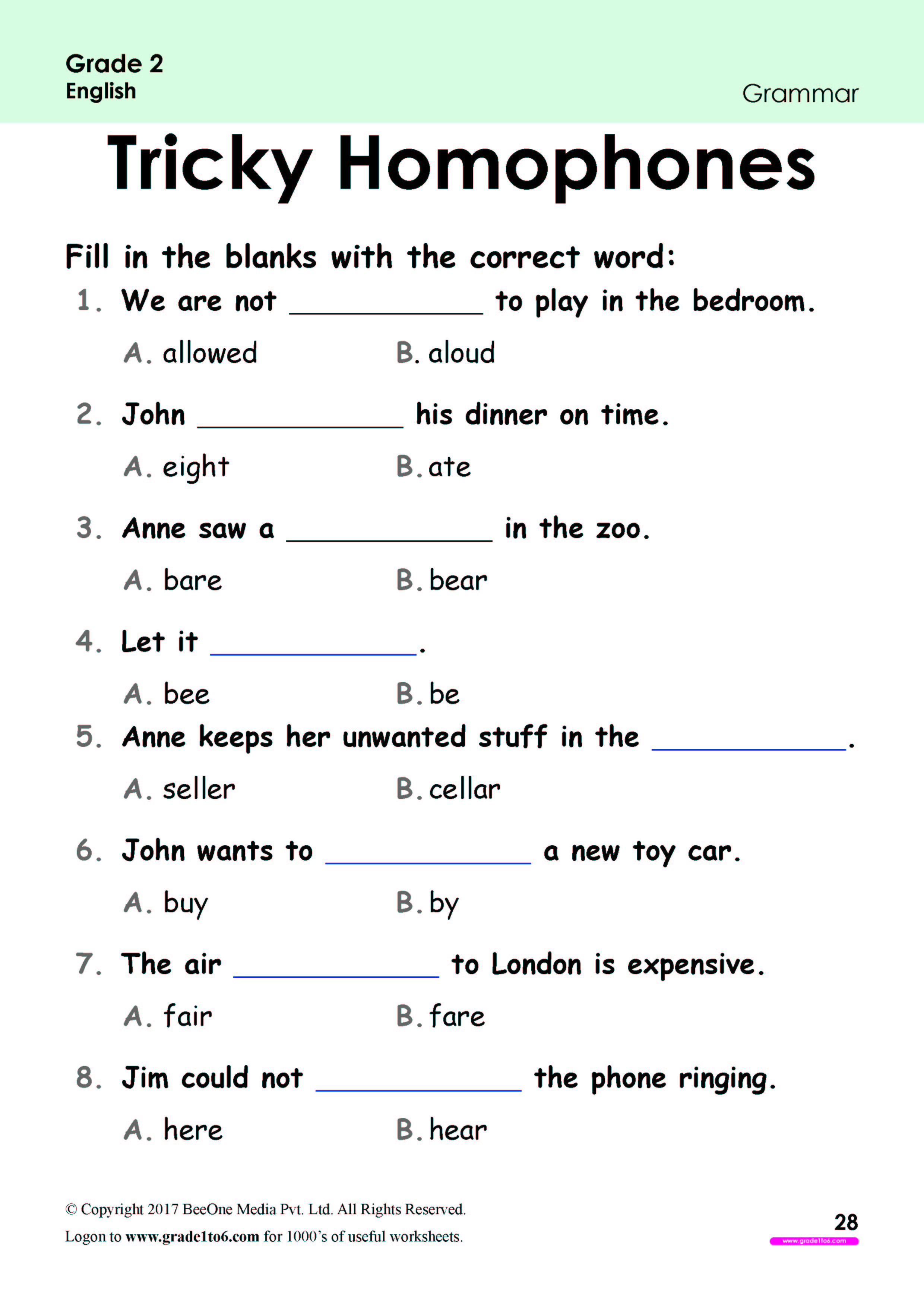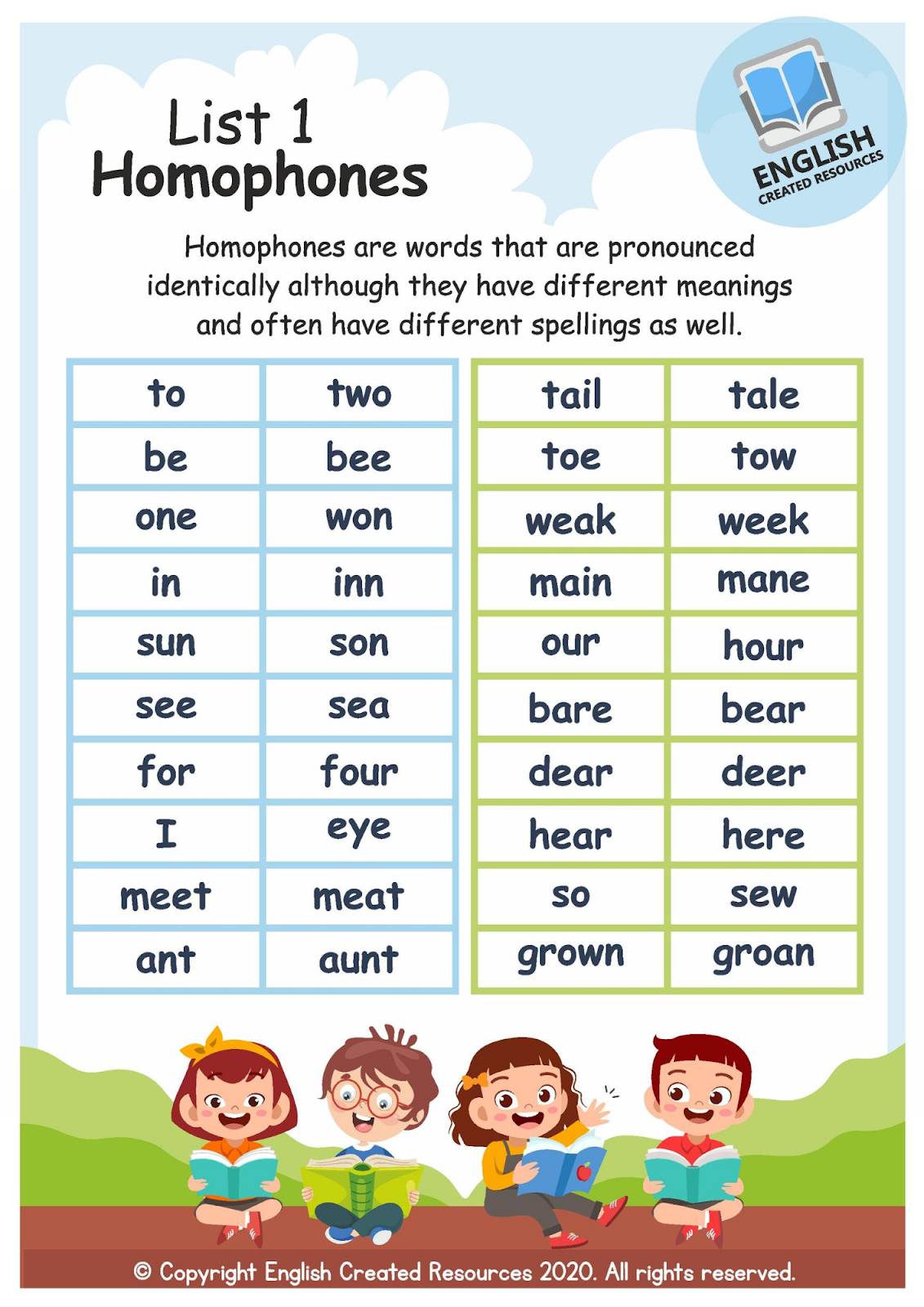
The Power of Precision: Mastering Language with Homophones Worksheets
Language, in its intricate beauty, often presents fascinating quirks that challenge even the most astute speakers and writers. Among these, homophones stand out as particularly deceptive linguistic twins. Homophones are words that sound exactly alike but have different spellings and meanings (e.g., "to," "too," and "two"; "their," "there," and "they’re"). Their existence is a constant source of confusion, leading to embarrassing errors, miscommunications, and a general decline in the clarity and professionalism of written work. This is precisely where homophones worksheets step in, serving as indispensable tools in the journey toward linguistic precision and mastery.
Unpacking the Homophone Phenomenon

To truly appreciate the value of targeted practice, it’s crucial to understand why homophones pose such a significant challenge. The human brain is wired to process auditory information efficiently. When we hear a word, our minds often jump to a common spelling or meaning, especially if we’re not actively considering context. This automatic processing works well for most words, but it becomes a pitfall with homophones.

Consider the simple sentence: "I went to the store too quickly, and now I have two bags." If a writer mistakenly types "I went too the store to quickly, and now I have to bags," the sentence becomes nonsensical, despite the words sounding correct when read aloud. The visual distinction on the page is paramount. This phenomenon is not limited to simple examples; it extends to more complex pairs like "compliment" vs. "complement," "affect" vs. "effect," "principle" vs. "principal," and "stationary" vs. "stationery." Each pair, while phonetically identical, carries entirely distinct connotations and grammatical functions. The subtle difference in spelling dictates a profound difference in meaning, making correct usage a cornerstone of effective communication.

The Crucial Importance of Homophone Mastery

Mastering homophones is not merely about avoiding grammatical errors; it is fundamental to developing strong literacy skills and ensuring clear, unambiguous communication.

- Clarity and Comprehension: In both academic and professional settings, clear communication is paramount. Misusing homophones can instantly obscure meaning, forcing the reader to pause, re-read, and infer the intended message. This breaks the flow of communication and can lead to misunderstandings, especially in instructions, reports, or legal documents where precision is non-negotiable.
- Professionalism and Credibility: In the digital age, written communication is more prevalent than ever. Emails, reports, resumes, and social media posts all contribute to one’s professional image. Consistent homophone errors can undermine a writer’s credibility, making them appear careless or uneducated. Conversely, accurate usage projects an image of attention to detail and linguistic competence, which are highly valued attributes.
- Reading Fluency and Understanding: While homophone errors primarily manifest in writing, a solid understanding of them also aids reading comprehension. When readers encounter a homophone, their brains must quickly select the correct meaning based on context. Familiarity with the various spellings and their associated meanings allows for smoother, more efficient reading, reducing cognitive load and enhancing overall understanding of the text.
- Vocabulary Expansion: Learning homophones often involves delving into the nuanced meanings of words. This process naturally expands a learner’s vocabulary and deepens their appreciation for the subtle distinctions within the English language. It encourages a more thoughtful and deliberate approach to word choice.
- Foundation for Advanced Language Skills: A strong grasp of basic linguistic rules, including homophone usage, provides a solid foundation for more advanced language skills. It contributes to better critical thinking about language, improved editing abilities, and a greater capacity for eloquent and persuasive writing.

Why Homophones Worksheets are Essential Learning Tools
Given the complexities and importance of homophone mastery, passive learning simply isn’t sufficient. Learners need structured, repetitive, and contextualized practice. This is precisely why homophones worksheets are not just supplementary materials but essential pedagogical instruments.

Unlike simply memorizing definitions, worksheets provide an active learning environment. They force learners to:
- Engage Actively: Rather than passively reading about homophones, students must actively choose, write, or correct them. This hands-on approach reinforces learning more effectively.
- Practice in Context: Most worksheets present homophones within sentences or short paragraphs, demonstrating their usage in real-world contexts. This is vital, as meaning is often derived from the surrounding words.
- Identify and Correct Errors: Worksheets often include exercises specifically designed for error identification, training the brain to spot common mistakes and understand the logic behind correct usage.
- Build Muscle Memory: Repetitive exposure and practice through diverse exercises help build "muscle memory" for correct spelling and usage, making the right choice more automatic over time.
- Assess Progress: For educators and self-learners alike, worksheets offer a tangible way to assess understanding and identify areas that require further attention.

A Spectrum of Engaging Homophones Worksheets
The effectiveness of homophones worksheets lies in their variety. Different types of exercises cater to various learning styles and reinforce different aspects of homophone mastery:
- Matching Exercises: These foundational worksheets pair homophones with their definitions or with sentences illustrating their correct usage. They are excellent for initial exposure and reinforcing basic recognition.
- Fill-in-the-Blank: Perhaps the most common type, these exercises present sentences with a blank space where the correct homophone (chosen from a provided list or from memory) must be inserted. This directly tests contextual understanding.
- Example: The ____ (bear/bare) trees stood against the winter sky.
- Sentence Creation: Learners are given a pair or trio of homophones and tasked with creating original sentences that correctly use each word. This encourages creative thinking and deeper comprehension of each word’s meaning.
- Error Identification and Correction: These challenging worksheets present sentences or paragraphs containing deliberately misused homophones. Students must identify the errors and correct them. This hones critical reading and editing skills.
- Example: Please here is my opinion on the hear subject. (Correct: Here is my opinion on the here subject.)
- Multiple Choice: Similar to fill-in-the-blank, but offering a selection of choices, including distractors, to test precise understanding.
- Picture-Based Worksheets: Especially beneficial for younger learners or visual learners, these worksheets use images to represent homophones, helping to solidify the connection between sound, spelling, and meaning (e.g., a picture of a "knight" next to a picture of "night").
- Dictation Exercises: While not strictly a "worksheet" in the traditional sense, combining dictation with a written response sheet serves as an excellent homophone exercise. Learners hear the word and must correctly spell it based on the context of the dictated sentence.
- Contextual Passages: More advanced worksheets might feature longer passages or stories where students must identify and correct homophone errors, or choose the correct homophone from a list to complete the narrative. This simulates real-world reading and writing scenarios.
Crafting and Implementing Effective Homophones Worksheets
For educators, parents, or self-learners designing their own practice, the quality of homophones worksheets significantly impacts their effectiveness.
- Clear Instructions: Ensure instructions are concise and unambiguous.
- Varied Exercises: Don’t stick to just one type; mix and match to keep learners engaged and reinforce different skills.
- Gradual Difficulty: Start with simpler, more common homophones and gradually introduce more challenging pairs.
- Contextual Relevance: Use sentences that are relatable and meaningful to the learner. Abstract sentences can hinder comprehension.
- Provide Answer Keys: Immediate feedback is crucial for learning. Learners should be able to check their answers and understand their mistakes.
- Integrate with Other Subjects: Homophone practice can be seamlessly integrated into history, science, or literature assignments, making the learning more interdisciplinary.
- Make it Fun: Incorporate elements of gamification, riddles, or competitive exercises to make learning less of a chore.
The Broad Impact: Who Benefits from Homophones Worksheets?
The utility of homophones worksheets extends across various demographics and learning stages:
- ESL/EFL Learners: For non-native speakers, homophones are particularly challenging as they navigate new phonetics, spellings, and semantic nuances. Worksheets provide structured practice essential for building confidence and accuracy.
- Young Learners: As children develop their reading and writing skills, homophones are often a stumbling block. Engaging worksheets help them differentiate these tricky words early on, preventing ingrained errors.
- Students with Learning Differences: Learners with dyslexia or other language-based learning disabilities can benefit immensely from the explicit, repetitive, and multi-sensory nature of well-designed homophone exercises.
- Adults Seeking Improvement: Professionals, writers, or anyone looking to refine their communication skills can use worksheets for self-study and targeted improvement.
- Native Speakers Struggling with Literacy: Even native English speakers can struggle with homophones. Worksheets offer a systematic way to address these persistent errors.
Beyond the Page: Complementary Strategies for Homophone Mastery
While homophones worksheets are undeniably powerful, they are most effective when part of a broader language learning strategy. Complementary activities include:
- Extensive Reading: Exposure to correctly used homophones in a wide variety of texts helps reinforce proper usage subconsciously.
- Regular Writing Practice: The act of writing forces learners to make conscious choices about word usage, solidifying their understanding.
- Vocabulary Building: A robust vocabulary helps in understanding the subtle distinctions between homophones.
- Spelling Bees and Games: Engaging in competitive or game-based learning can make the process enjoyable and memorable.
- Proofreading and Editing: Developing a keen eye for one’s own errors is a crucial skill honed through dedicated proofreading practice.
- Using Online Resources: Many websites offer interactive homophone quizzes and games that provide immediate feedback.
Conclusion
Homophones, with their deceptive simplicity, represent a significant hurdle in the path to clear and effective communication in English. Yet, they are not insurmountable. Through systematic, targeted, and engaging practice, learners of all ages and backgrounds can conquer these linguistic challenges. Homophones worksheets stand as a cornerstone of this educational endeavor, offering the structured repetition and contextual application necessary to transform confusion into clarity. By diligently utilizing these invaluable resources, students and lifelong learners alike can elevate their linguistic precision, ensuring their messages are not just heard, but truly understood. The journey to language mastery is paved with attention to detail, and in the realm of homophones, precision is truly power.
